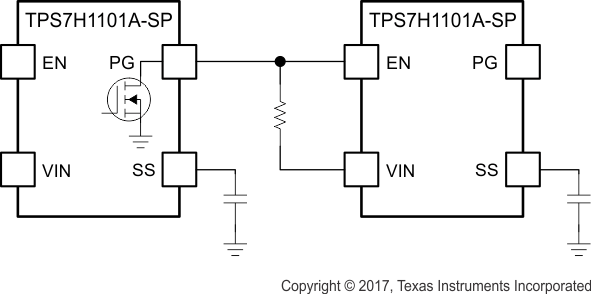SLVSDW6C April 2017 – April 2021 TPS7H1101A-SP
PRODUCTION DATA
- 1 Features
- 2 Applications
- 3 Description
- 4 Revision History
- 5 Pin Configuration and Functions
- 6 Specifications
- 7 Detailed Description
- 8 Application and Implementation
- 9 Power Supply Recommendations
- 10Layout
- 11Device and Documentation Support
- 12Mechanical, Packaging, and Orderable Information
Package Options
Mechanical Data (Package|Pins)
- HKR|16
- KGD|0
Thermal pad, mechanical data (Package|Pins)
Orderable Information
7.3.2 Power Good (PG)
Power Good terminal (9) is an open-drain connection and can be used to sequence multiple LDOs. Figure 7-1 shows typical connection. The PG terminal will be pulled low until the output voltage reaches 90% of its maximum level. At that point, the PG pin will be pulled up. Since the PG pin is open drain, it can be pulled up to any voltage as long as it does not exceed the absolute max of 7.5 V listed in Section 6.5.
 Figure 7-1 Sequencing LDOs With Power Good
Figure 7-1 Sequencing LDOs With Power GoodNote:
For PSpice models, WEBENCH, and reference design, see the Design & development tab of the product folder.
- PSpice transient model (switching, transient, and stability simulations)
- PSpice Worst Case Analysis (WCA) model (radiation and aging stability – Bode plot)